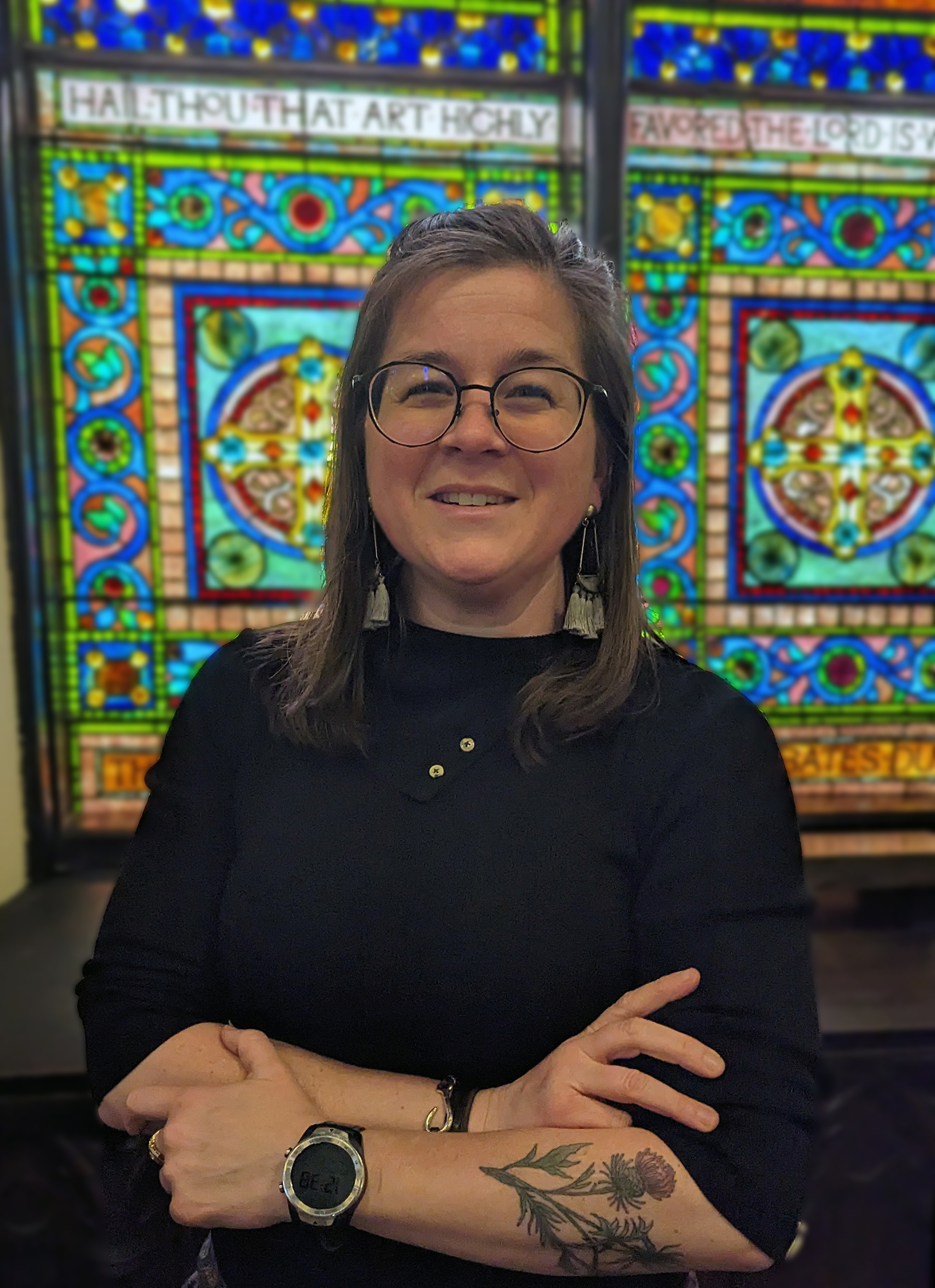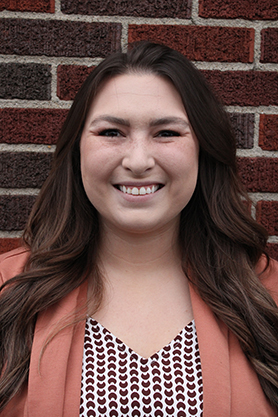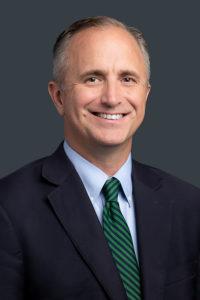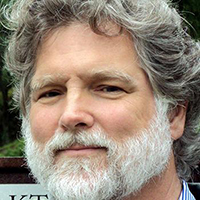Webinar: An Exploration of the American Stained Glass Industry
Wednesday, May 22nd – 1:00 pm – 2:00 pm
Explore the rich history of American stained glass and the niche industry that supports so much of our architectural art glass environment. Looking to the future of stained glass restoration, we find ourselves at a pivotal moment. Success hinges upon our willingness to embrace creativity, and our ability to draw insights from past endeavors and forge collaborative pathways with communities. Fortunately, our history is steeped in a tradition of collaboration, service, and ingenuity, providing a sturdy foundation upon which to build.
About Our Presenter
 Megan McElfresh is a third-generation stained glass artisan who became Executive Director of the Stained Glass Association of America (SGAA) in Fall of 2017. Her background in operations management and art history gives her unique qualifications as the leader for the National Trade Association as it celebrates its 120th anniversary of service to the industry. In her role with the SGAA, McElfresh is focused on sowing the seeds of long-term change and expanding the SGAA’s core programs. Her focus is on showcasing the Association as a hub for the industry through strong partnerships with manufacturers, preservation and stewardship groups, and education centers. By bringing together the nation’s foremost architectural art glass studios in technical skill and integrity, the Stained Glass Association’s cumulative knowledge can be combined for the benefit of all who are tasked with the care and investment of our nation’s living stained glass museum.
Megan McElfresh is a third-generation stained glass artisan who became Executive Director of the Stained Glass Association of America (SGAA) in Fall of 2017. Her background in operations management and art history gives her unique qualifications as the leader for the National Trade Association as it celebrates its 120th anniversary of service to the industry. In her role with the SGAA, McElfresh is focused on sowing the seeds of long-term change and expanding the SGAA’s core programs. Her focus is on showcasing the Association as a hub for the industry through strong partnerships with manufacturers, preservation and stewardship groups, and education centers. By bringing together the nation’s foremost architectural art glass studios in technical skill and integrity, the Stained Glass Association’s cumulative knowledge can be combined for the benefit of all who are tasked with the care and investment of our nation’s living stained glass museum.
The Stained Glass Association of America, founded in 1903, is a 501(c)6 national professional trade association serving the architectural ornamental art glass industry across
North America and Internationally. In December 2017, the national headquarters office moved to Buffalo, NY. Coming up on its 120th anniversary, they are focused on strengthening their 501(c)3 Foundation, expanding their mission, and serving our nation’s emerging professionals.
The SGAA Foundation was founded in 2020 to promote public appreciation and knowledge of the stained glass and mosaic art form and champion the provenance of the material in architectural art. The mission of the Foundation is to foster proactive, responsible stewardship of our nation’s architectural art glass and mosaic treasures. Beauty must be abundant and accessible and we must collaborate with like-minded organizations to bring new voices into our industry while providing more resources to protect our nation’s stained glass heritage.

Webinar: Top Tips for National Register Nominations
Wednesday, March 27th – 1:00 pm – 2:00 pm
What is the National Register of Historic Places? This webinar will cover the basics of what the National Register of Historic Places program is, what being listed in the program does and does not mean, and what benefits may come with a listing. Additionally, this webinar will outline the process of nominating resources to the National Register of Historic Places and provide insight and tips to preparing a nomination.
This webinar is registered for 1.00 LU AIA credit.
About Our Presenter
 Abby Marshall, Survey and National Register Manager for Inventory and Registration for the State Historic Preservation Office of the Ohio History Connection, holds a Bachelor’s of Science degree in Geography with a concentration in Travel and Tourism as well as a Master’s of Science degree in Historic Preservation – both from Ball State University. She began working at the Ohio State Historic Preservation Office in 2021 and currently serves on the Heritage Ohio Board as the Young Ohio Preservationist’s chair.
Abby Marshall, Survey and National Register Manager for Inventory and Registration for the State Historic Preservation Office of the Ohio History Connection, holds a Bachelor’s of Science degree in Geography with a concentration in Travel and Tourism as well as a Master’s of Science degree in Historic Preservation – both from Ball State University. She began working at the Ohio State Historic Preservation Office in 2021 and currently serves on the Heritage Ohio Board as the Young Ohio Preservationist’s chair.

Webinar: Redevelopment Funding Opportunities from the Ohio Department of Development
Wednesday, January 31st – 1:00 pm – 2:00 pm
Join us for a conversation about community redevelopment and the funds available through the Ohio Department of Development to assist your projects. Funding opportunities to be discussed include:
Welcome Home Ohio
The Welcome Home Ohio (WHO) program is designed to provide grants for the purchase of qualifying residential properties, the cost of construction or rehabilitation, or a nonrefundable tax credit for qualifying activities.
Brownfield Remediation Program
The Brownfield Remediation Program provides grants for the cleanup of brownfield sites, to assist in the remediation of hazardous substances or petroleum at an industrial, commercial, or institutional property. Remediation includes acquisition of a brownfield, demolition performed at a brownfield, and the installation or upgrade of the minimum amount of infrastructure necessary to make a brownfield site operational for economic development activity.
Building Demolition and Site Revitalization Program
The Building Demolition and Site Revitalization Program is designed to provide grants for the demolition of commercial and residential buildings and revitalization of surrounding properties on sites that are not Brownfields.
Water and Wastewater Infrastructure Grant Program
The Water and Wastewater Infrastructure Grant Program provides grants to improve access to clean drinking water and wastewater infrastructure. Grants of up to $5 million for construction projects are available to Ohio communities. All political subdivisions with the authority to own and operate public water and sewer systems and non-profit, non-community public water systems may submit an application

Webinar: Historic Preservation Commissions: The Legal Basics
Wednesday, February 21st – 1:00 pm – 2:00 pm
The strongest defense commissions have against accusations of arbitrary and capricious decisions is to consistently follow established review procedures. Customized for each state, this workshop covers the legal basis for commission operation. This presentation will provide an overview of procedural due process, takings, appeals, property rights, and economic hardship. Participants will examine common preservation legal issues and acquire tools to improve decision-making and build a defensible record.
About our presenter:
 Will Cook is a nationally recognized lawyer and scholar with a successful record for protecting National Historic Landmarks, significant landscapes, historic viewsheds, and traditional cultural properties. His practice focuses on balancing historic preservation with economic development so that historic preservation law is more efficient, effective, and predictable. Will helps his clients navigate the Section 106 process of the National Historic Preservation Act at the project level with an emphasis on historic viewsheds and landscape protection. He negotiates on behalf of tribes, project proponents, local governments, and other consulting parties to achieve creative, win-win outcomes that appropriately balance preservation values and development needs. Examples of his work include helping to find reasonable limits to unregulated cruise tourism in historic port communities, advising a local government with a National Historic Landmark district on its legal rights in response to proposed offshore utility-scale windfarms, and working with a nationally recognized preservation advocacy group on how to address a proposed seawall that would surround a National Historic Landmark district.
Will Cook is a nationally recognized lawyer and scholar with a successful record for protecting National Historic Landmarks, significant landscapes, historic viewsheds, and traditional cultural properties. His practice focuses on balancing historic preservation with economic development so that historic preservation law is more efficient, effective, and predictable. Will helps his clients navigate the Section 106 process of the National Historic Preservation Act at the project level with an emphasis on historic viewsheds and landscape protection. He negotiates on behalf of tribes, project proponents, local governments, and other consulting parties to achieve creative, win-win outcomes that appropriately balance preservation values and development needs. Examples of his work include helping to find reasonable limits to unregulated cruise tourism in historic port communities, advising a local government with a National Historic Landmark district on its legal rights in response to proposed offshore utility-scale windfarms, and working with a nationally recognized preservation advocacy group on how to address a proposed seawall that would surround a National Historic Landmark district.
In 2019, Will assisted the Parks & People Foundation in Baltimore with identifying ways to use Section 106 to leverage shoreline restoration of the Middle Branch Harbor and proposed “green” urban park along its 11-mile shoreline. Will’s extensive knowledge of preservation legal tools and land use law allows him to serve as a strategic partner with policymakers, developers, and preservation advocates on best practices to make preservation law more effective and efficient. Examples include assisting the City of Philadelphia and the Town of Palm Beach with identifying strengths and weaknesses in their local preservation laws, suggesting opportunities for improvement based on peer city reviews, and helping educate the public about preservation law’s benefits. Through his work with the National Alliance of Preservation Commission’s Disaster Planning Advisory Committee, Will helps historic communities with adaptation planning and disaster relief, including their response to the COVID-19 pandemic. Will has argued in court and before administrative agencies across the country on behalf of advocates seeking to protect traditional cultural properties: historic places that continue to be used by living communities. His engagements have included arguing on behalf of the National Trust for Historic Preservation before the New Mexico Supreme Court, which affirmed unanimously Mount Taylor’s designation in New Mexico’s State Register of Cultural Properties.
Will earned his Juris Doctor from the University of South Carolina School of Law, and is a graduate of Furman University, where he received a B.A. in political science. Prior to joining Cultural Heritage Partners, Will served for eight years as associate general counsel for the National Trust for Historic Preservation and teaches preservation law at Columbia University.

Heritage Ohio issues RFP for Franklinton (Columbus) religious resources history & architecture survey
Heritage Ohio is pleased to announce a Request For Proposals to complete a history & architecture survey in the Franklinton neighborhood of Columbus. You can learn more and access the RFP here. Proposals are due no later than January 19, 2024.
Webinar: Historic Properties and Affordable Housing in Ohio’s Appalachia Region
Wednesday, January 17th – 1:00 pm – 2:00 pm
Most small towns in rural Ohio are blighted by older homes in varying states of dilapidation. Many of these homes are no longer occupied or even occupiable. Often these houses, while perhaps lacking in historical significance, nonetheless are representative of their communities’ cultural heritage. Thus, their loss, in addition to being a significant economic negative and a loss of affordable housing stock, also constitutes an erosion of architectural distinctness and community identify. But unlike historic properties, for which numerous programs exist to encourage and support their preservation, such “heritage housing” has received little comparable attention. This phenomenon presents an opportunity in which the rehabilitation of older housing stock can improve affordable first-time home ownership while generating employment, income, and wealth, and preserving community identity.
Mr. Lane will discuss his research at the Ohio University Voinovich School of leadership and Public Service which examined the opportunity to enhance Athens County’s supply of more affordable housing through the rehabilitation of older single-family houses – “heritage houses” – that have fallen into disrepair and are uninhabited. In this study, the term “attainable heritage housing” was coined to describe existing older home in need of repair, that are priced below conventional definitions of affordability and which – while typically lacking in historical significance, are nonetheless distinctly representative of their communities’ pasts. The study found that a program of targeted older house rehabilitation could produce significant short- and long-term positive economic impacts for current and prospective residents, while enhancing a community’s position to leverage aesthetic heritage distinctiveness to capitalize on emergent economic opportunities.
This webinar has been approved for 1.00 AIA HSW credit.
About our presenter:

Brent Lane is a Senior Executive in Residence at the Voinovich School of Leadership and Public Service at Ohio University, which he joined in 2020. In his career he has been an early-stage venture capitalist, developed and run business incubators, led state-level economic development programs teams, and directed a university applied economic strategies center. At the Voinovich School he designs and leads in analyses of novel economic and community development opportunities in Appalachian Ohio, especially those capitalizing on the region’s distinctive cultural and natural heritage assets. Brent has earned masters’ degrees in science and technology policy from the George Washington University and in business administration from the University of North Carolina.


